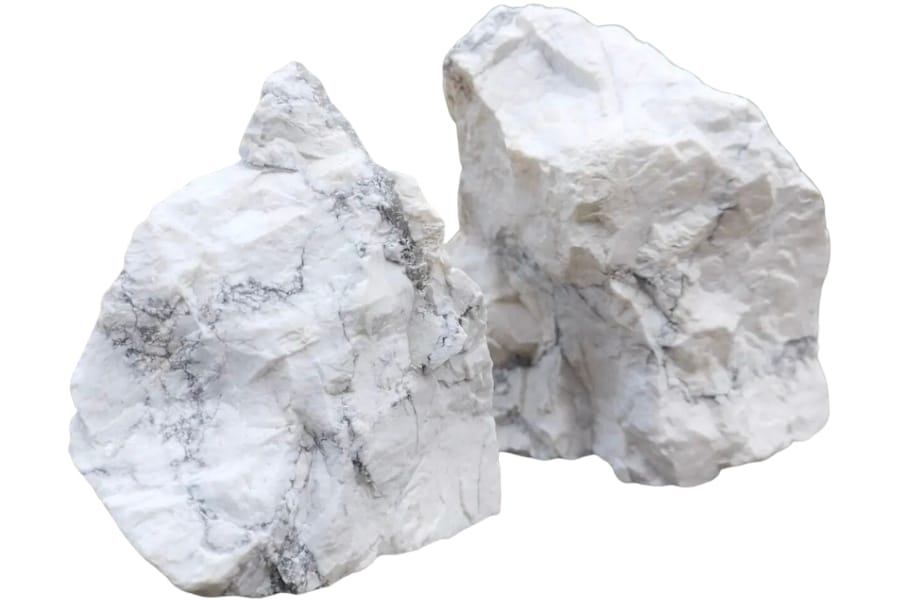Magnesite and howlite are two fascinating rocks that often get mixed up. But while they might look quite similar at first glance— both can be white and have a sort of understated beauty— they’re not the same once you get to know them.
In this article, we’re going to explore the differences between magnesite and howlite so you won’t mistake one for the other again. We’ll also discuss the major similarities that these two natural treasures share.
You might wonder, “Why should we care about these rocks?” Magnesite and howlite aren’t just any stones. They have a role in everything from jewelry to the products we use every day. On top of it, they’ve been part of human history for a long time.
Their many uses make it all the more important to get to know them. And by the end of this, you’ll be able to tell magnesite vs howlite as easily as telling cats from dogs.
Magnesite vs Howlite – The Major Differences
Many people find distinguishing magnesite from howlite to be difficult, especially since they can look so much alike. But you’ll be surprised to know that these two rocks share more differences, such as:
Color – Magnesite is usually white with a bit of other colors
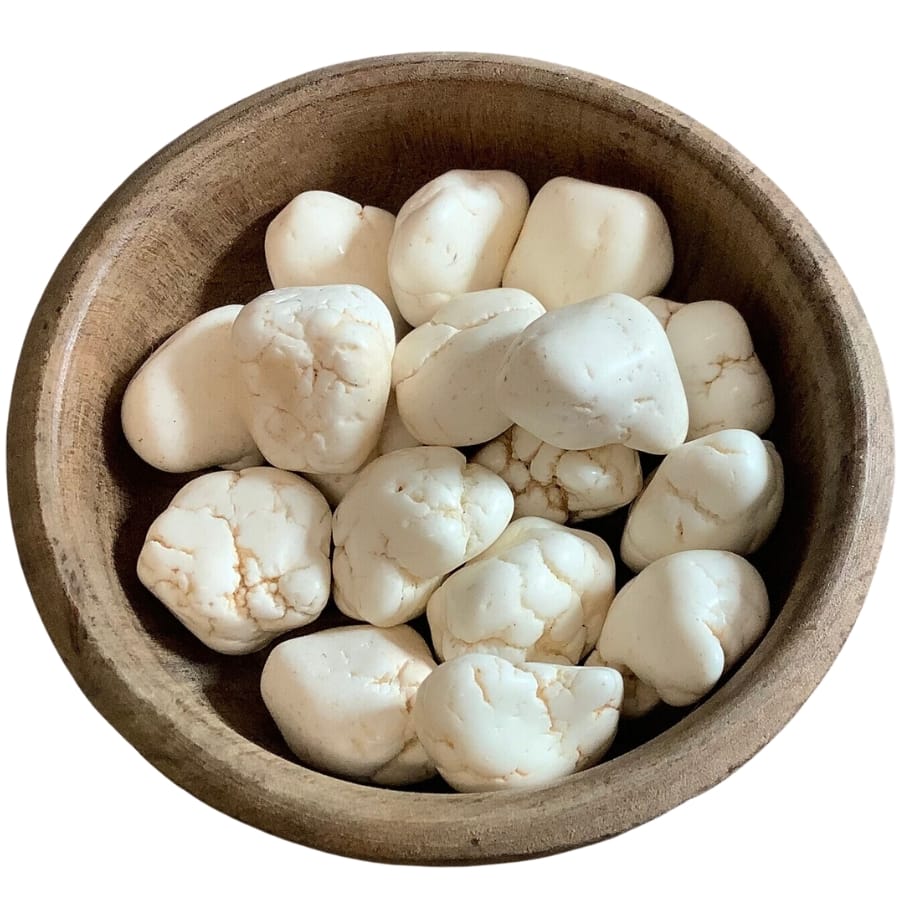
When you look at magnesite and howlite, they might first seem like twins. Both of them often show off a snowy white color that can fool almost anyone.
But, like twins with different personalities, they have unique features that set them apart.
Magnesite is usually just white or sometimes steps out with a bit of yellow, gray, or even a soft pink color when it has impurities. Think of it like a plain vanilla ice cream cone with sprinkles.
Howlite, on the other hand, is also mostly white, but it has grayish or black veins running through it, making it look like a network of tiny roads on a map or a spider web. These lines, called matrix or veining, make each piece unique.
But here’s where it gets fun: howlite is like a chameleon because it can be dyed into a rainbow of colors. People love to color it blue or green to make it look like more expensive stones, such as turquoise.
Luster – Howlite exhibits a glossier sheen
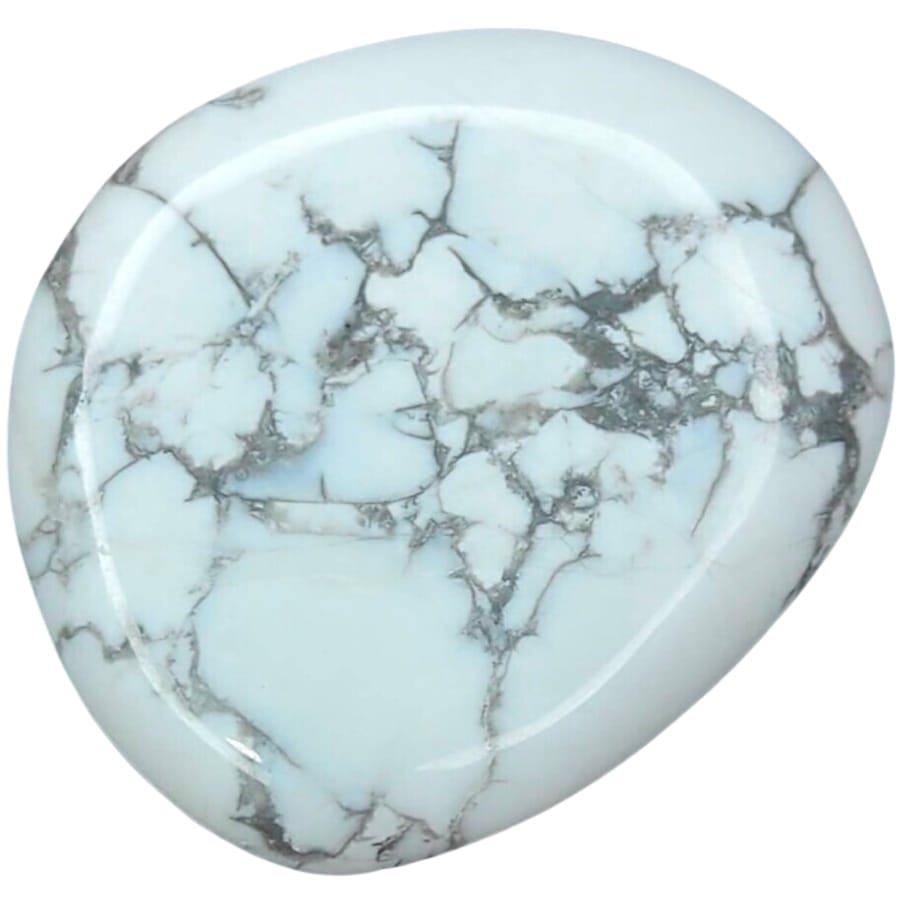
If rocks were stars in the night sky, luster would be how brightly they twinkle. This luster is one way to tell magnesite and howlite apart.
Magnesite has a pretty shy twinkle. It’s often got this dull, matte finish that doesn’t catch the light much.
Even when it’s polished, magnesite’s shine is more like a soft glow than a bright shine. It’s never going to blind you with its sparkle.
Howlite, while it’s a lot like magnesite in many ways, steps up the game in the luster department. It can be kind of glossy, like a page in a new magazine. When you polish it, it can really shine up, looking almost silky.
If magnesite is like a dusty baseball, then howlite is like a shiny bowling ball, especially after it’s been given a good wax.
Crystal Structure – Magnesite is built in a trigonal system

When we talk about the crystal structure of rocks, we’re diving into their architecture and the way their parts are put together on the inside. In this aspect, magnesite and howlite are like two houses with different floor plans.
Magnesite is built in a trigonal system. Picture a bunch of tiny blocks shaped like little pyramids or prisms, all lined up in threes, making a pattern that repeats over and over.
This gives magnesite its unique shapes. But you don’t usually see those shapes because they’re super small or just not well-formed.
Howlite, on the other hand, is made up using the monoclinic system. Imagine a wonky, slanted grid where all the blocks aren’t lined up straight. This rock doesn’t like to show off its structure either; it usually looks like a blob with no clear shape.
You won’t see fancy pyramid shapes in howlite. Instead, it’s kind of like a clump of clay before it’s been molded.
Cleavage – Howlite has poor cleavage
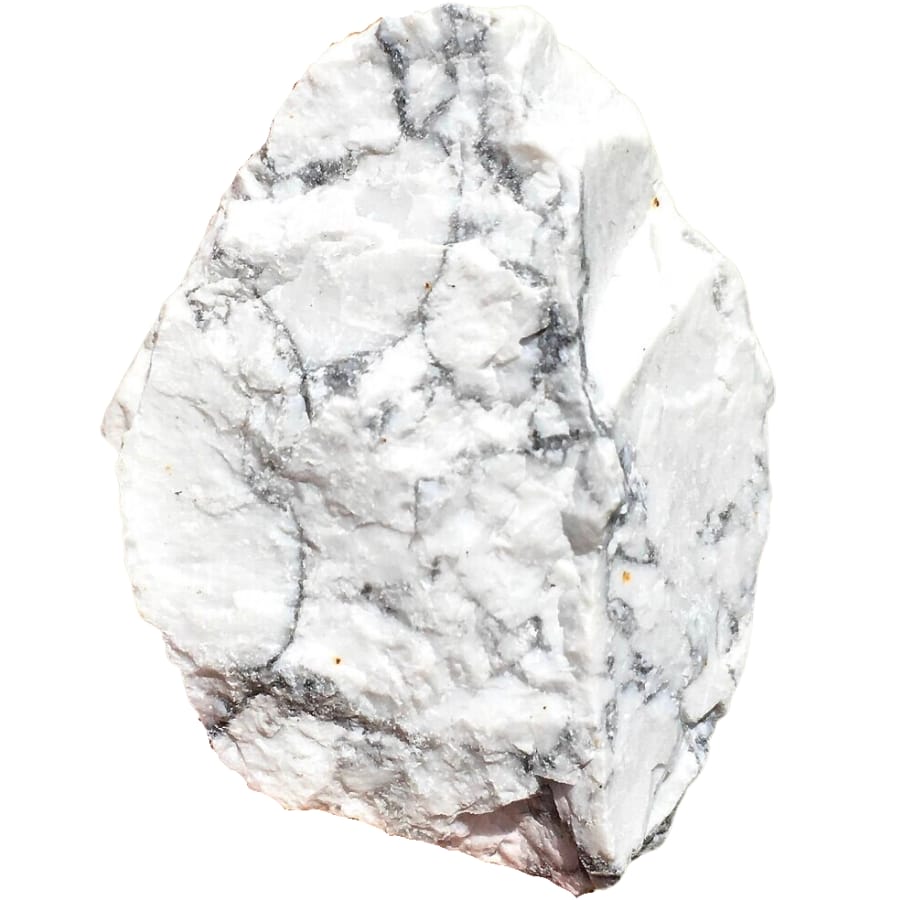
If you could slice a rock, its cleavage is where it would split into neat, flat pieces. Magnesite and howlite have their own style of breaking.
Magnesite knows exactly where to split. It has what’s called perfect cleavage. So, if you were to break it, it would crack along straight, flat surfaces every single time.
It’s like when you snap a bar of chocolate along the lines into neat squares; that’s how magnesite likes to break.
Howlite, meanwhile, is different. Instead of breaking into flat pieces, it tends to break into uneven chunks. It has what we call poor cleavage, which means it doesn’t have a consistent pattern of breaking.
If you tried to snap a howlite like that bar of chocolate, you’d end up with a bunch of different-sized pieces, none of them quite the same shape or size.
Composition – Magnesite is made of magnesium carbonate
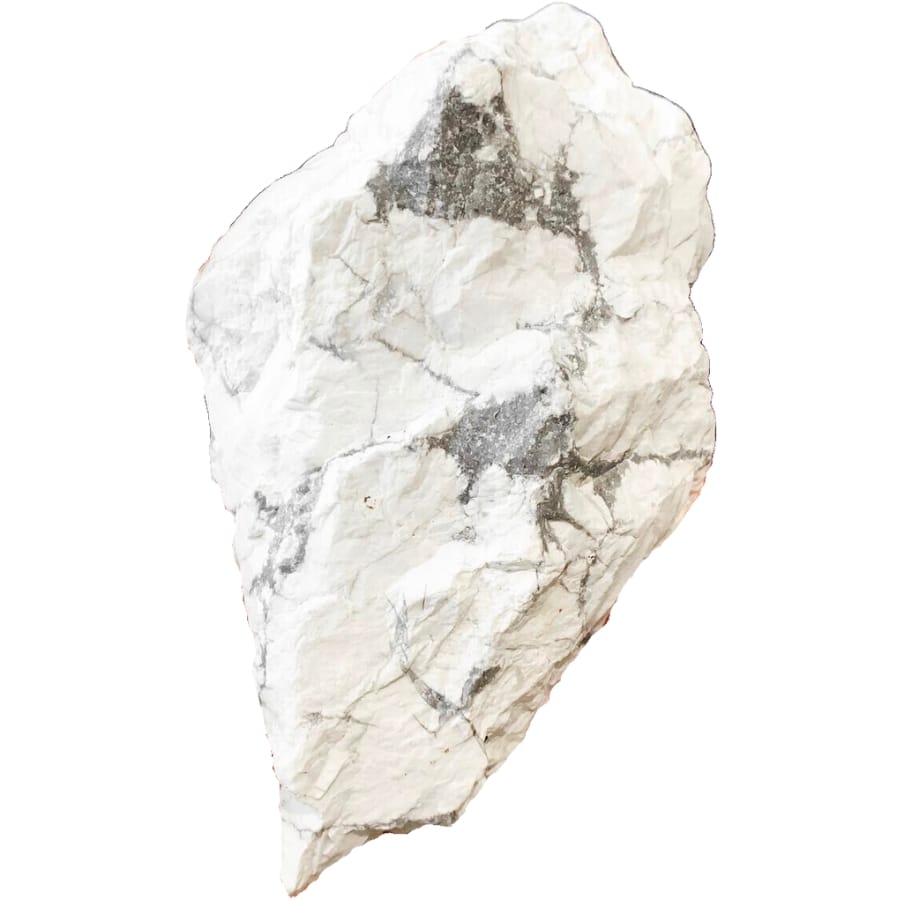
Just like cakes can have different ingredients, rocks like magnesite and howlite are made up of different stuff.
Magnesite has a simple recipe: it’s mostly just one main ingredient called magnesium carbonate. That’s a combo of magnesium, carbon, and oxygen.
Sometimes, it also mixes in other things like iron or nickel, but mostly, it sticks to its main ingredient. These bits come together in a special way that makes magnesite what it is: a rock that’s often used for stuff like making fireproof materials.
Howlite’s recipe is a bit more complicated. It’s made of calcium borosilicate hydroxide. It’s a mouthful, but that’s only calcium, boron, silicon, and oxygen, plus some hydrogen.
This mix is a little more complicated than magnesite’s, and it’s what gives howlite its unique personality. And just like some cakes have frosting, this rock sometimes comes with extras or natural impurities that can add to its look.
Density – Howlite feels lighter in the hand
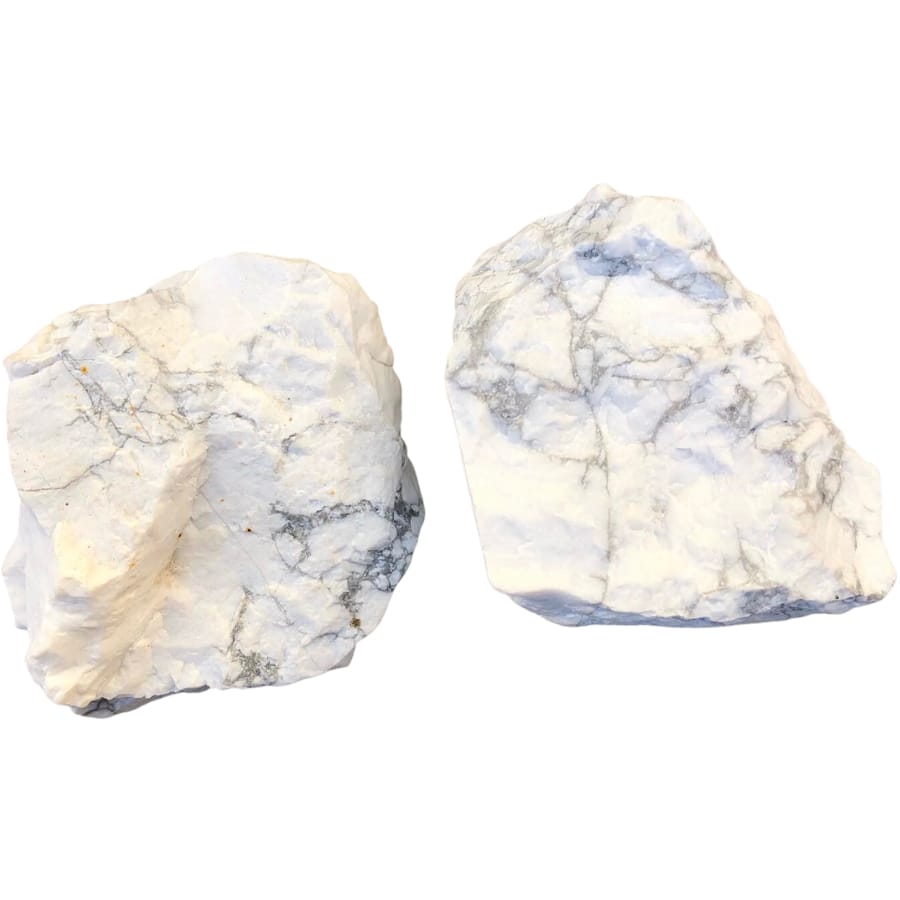
Density is all about how much stuff is packed into a rock. You can have two rocks that are the same size, but one can be heavier than the other because it has a denser packing of materials inside.
Magnesite is a bit heavier when you pick it up. It has a density that’s kind of like a backpack filled with books. It’s got more weight to it.
This is because the stuff inside it are packed in pretty tightly. If magnesite were packing for a hike, it would be the rock that brings a little extra, just in case.
Howlite, on the flip side, feels lighter, like a backpack with just a few snacks and a water bottle. Its density is lower, which means the bits that make it up aren’t as tightly packed together.
This difference in density is something rock hunters and geologists pay attention to. They can tell a lot about a rock by how heavy it feels in their hand.
Formation – Magnesite forms in a volcano’s side or sea floor

Magnesite and howlite come from different places on Earth and are made in different ways.
Magnesite forms in all sorts of places. You might find it where very hot water has passed through rocks deep underground, changing them over time. This hot water transforms the minerals in the rock into magnesite.
It can also form from the remains of tiny sea creatures piled up over millions of years on the sea floor. So, magnesite’s birthplace can be as varied as a volcano’s side or the bottom of a quiet ocean.
On the other hand, howlite has a more humble start. It’s usually formed in places where water has evaporated from a lake or sea, leaving behind layers of minerals.
Imagine a puddle drying up in the sun, leaving a crusty white salt layer behind – that’s similar to how howlite forms. It’s often found in places called evaporite deposits, which are mineral leftovers from dried-up waters.
Fluorescence – Howlite glows under UV light
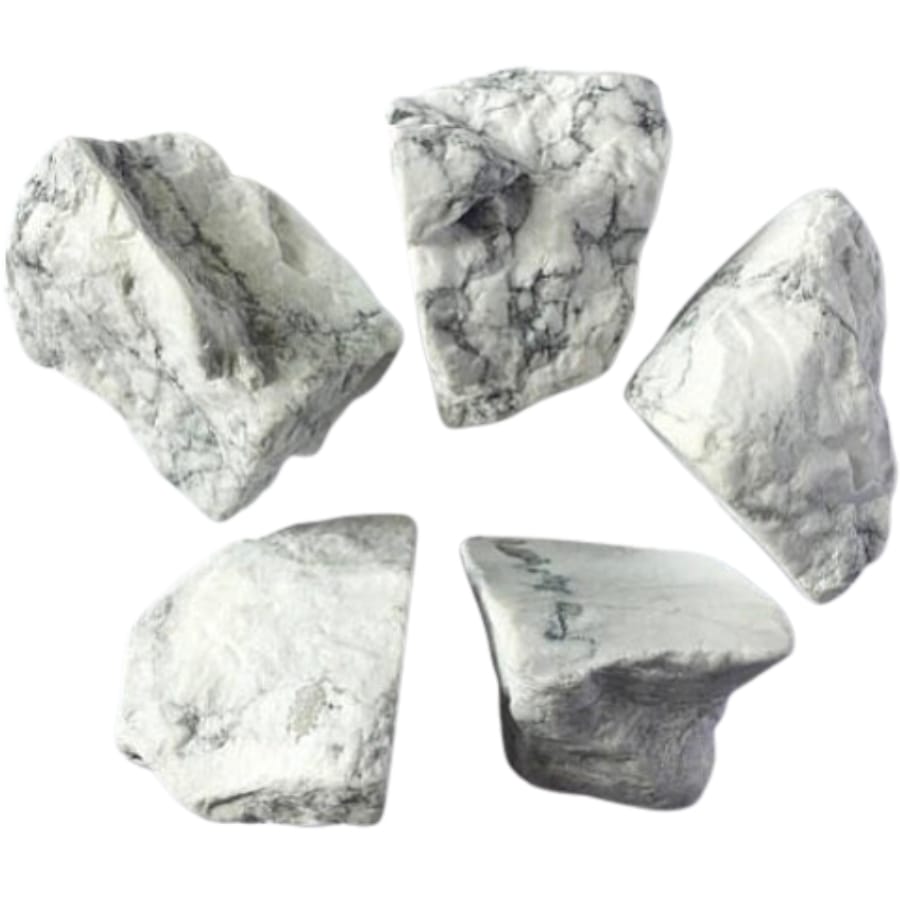
Fluorescence can only be seen under a special kind of light. When you shine an ultraviolet light on some rocks, they glow as if they’ve got a light bulb inside them. This trick is all about how the minerals in the rock react to the UV light.
Magnesite and howlite each have their own special glow, and it’s another clue that can help you tell them apart.
Most of the time, magnesite doesn’t like to show off. It usually doesn’t glow under UV light. But sometimes, if it has certain impurities, like a little bit of iron, it might give off a faint glow, but it’s not one of its defining properties.
Howlite is different. It loves the spotlight. Under UV light, it can put on a real show, glowing bright white or sometimes even blue.
This is a big deal for rock collectors because that glow can make howlite look cool and special.
Location – Magnesite occurs in more places
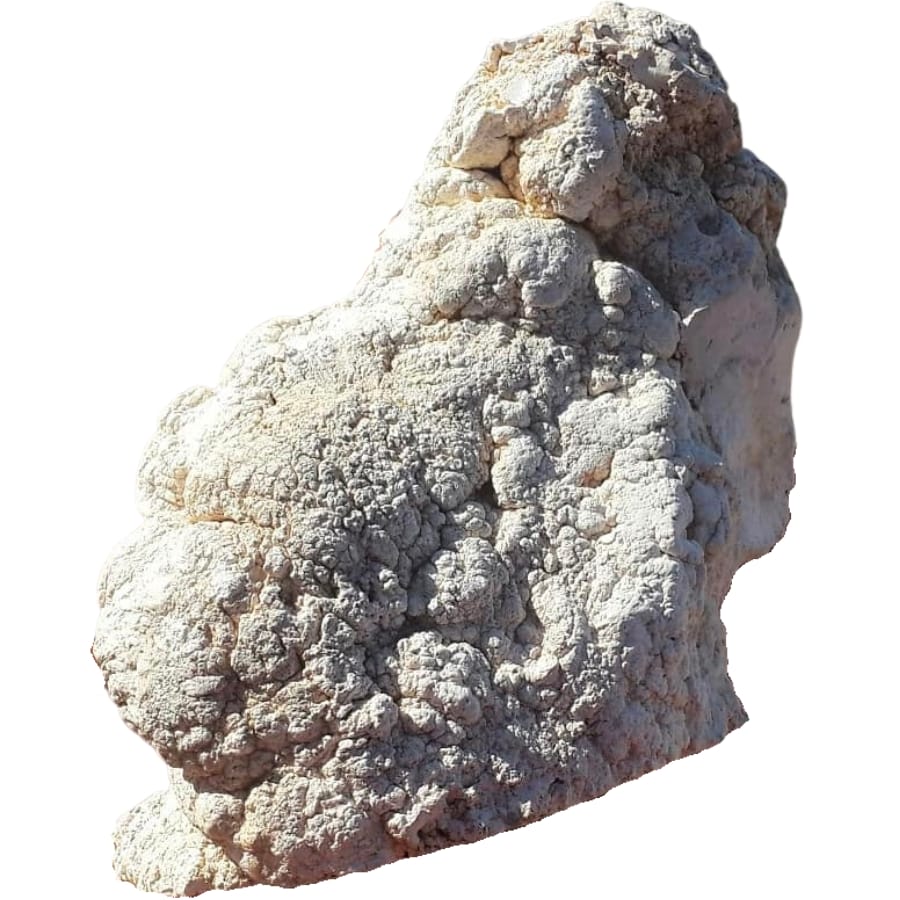
If rocks could tell you about all the places they’ve been, magnesite and howlite would have some interesting stories because they come from different spots around the world.
Magnesite has been everywhere. It’s found in many countries, like Austria, where it hangs out in the mountains, or Brazil, where it’s part of the tropical scenery.
Howlite is more like a friend who loves the beach. It tends to show up in places that were once old seas or lakes that have dried up. It’s not as much of a globetrotter as magnesite.
Most of the howlite people find comes from parts of Canada, like Nova Scotia, which is famous for its beautiful coasts and where it’s found in the rocky cliffs. You might also find it in parts of California in the United States.
To know the best rockhounding locations where you might find magnesite, howlite, and other rocks and minerals, check out our guide. You can also read our article on the gem mines near you.
Price – Howlite tends to be pricier

When it comes to the price tag of rocks, think of them like snacks. Magnesite is like the basic chips on the shelf. It’s usually not too expensive because it’s common and has a bunch of uses, but it’s not the fanciest snack you can buy.
Magnesite gets used a lot in things like making cement or in the science world, but it doesn’t usually get people excited like a rare gemstone would.
Howlite, on the other hand, is more like those fancy-flavored chips. It’s usually a little pricier than magnesite, especially when it’s been dyed to look like other more expensive gemstones.
People sometimes treat howlite to make it look like turquoise, which is a much-loved and pricier stone.
Their prices can also change depending on where they’re sold. A big chunk of raw magnesite might not cost much if you’re buying it from a mine. But if you’re looking at a howlite that’s been cut and polished for a necklace, the price could go up.
Magnesite vs Howlite – The Similarities
With magnesite and howlite, looking quite alike doesn’t mean they have tons of similarities. Below are the major areas where these two rocks are comparable to one another:
Hardness – Magnesite and howlite are both easy to scratch
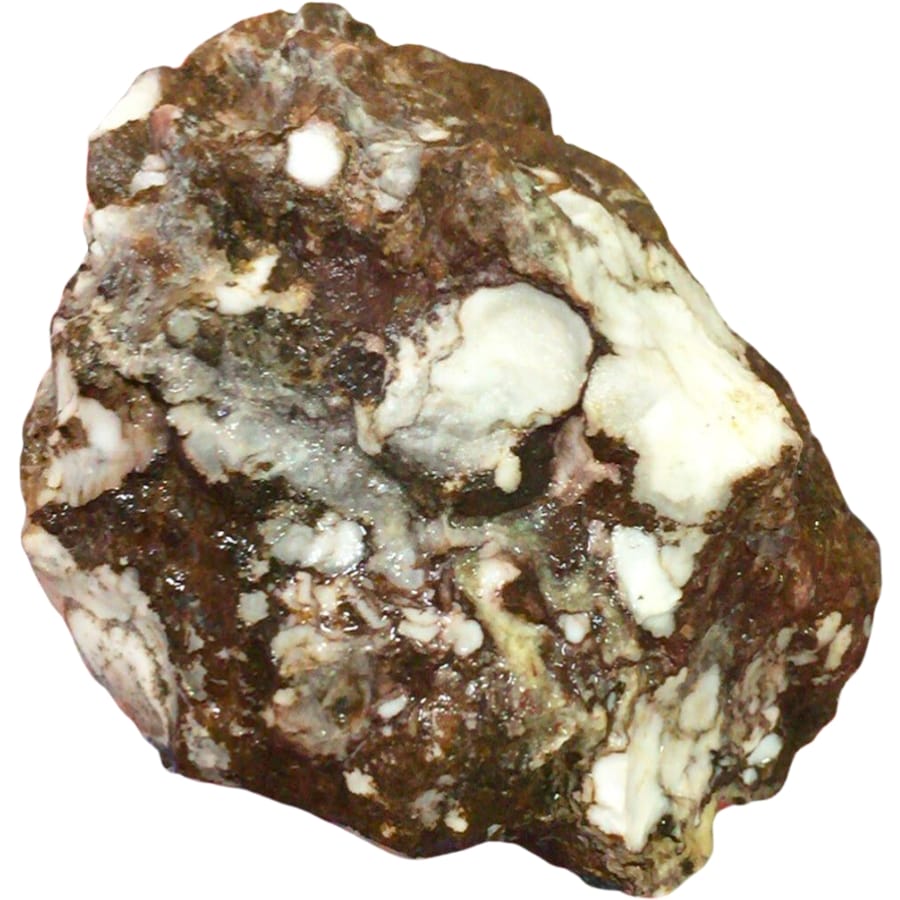
Magnesite and howlite are like siblings when it comes to hardness. Both of them are softer than a lot of other rocks you might find out in the wild.
They’re not as soft as a chunk of chalk from your classroom, but they’re not as hard as the diamond on a fancy ring, either. Magnesite and howlite could both get scratched by something as common as a pocket knife.
This means if you’re out hunting for rocks and you’ve got a magnesite or a howlite, you’d want to be a bit careful with them. Even if what you have is a pencil and you pressed it into the surface of these rocks, you’d probably leave a mark.
The reason they’re both on the softer side has to do with the way the minerals inside them are put together. They’re not packed in super tight like in harder rocks. This makes them easy to carve into shapes.
But while they’re not the toughest rocks on the block, their softness is what makes them so great for artists and jewelry makers.
Streak – Howlite and magnesite leave white streaks
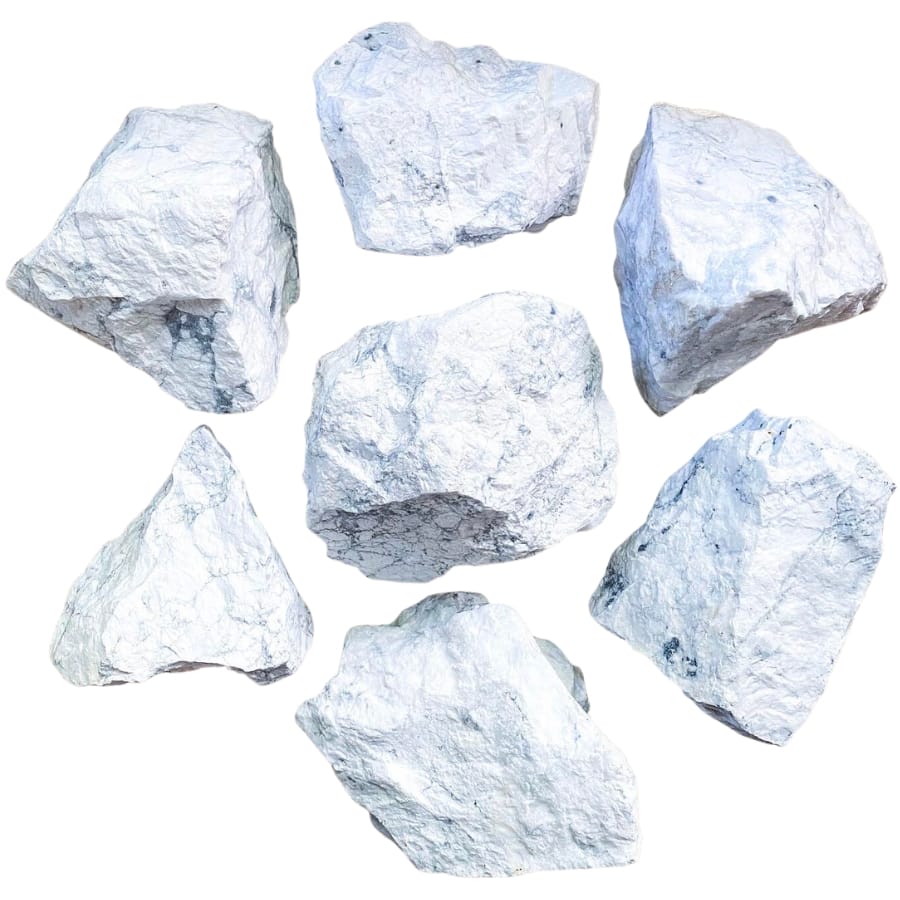
The streak of rocks isn’t about running fast; it’s about the color of the powder they leave when you scratch them on something rough. If you took a piece of chalk and scribbled it on the sidewalk, the streak is the mark it leaves behind.
Both magnesite and howlite share a secret signature move: they both leave a white streak. It’s something they both share, no matter what color they appear to be on the outside.
Even if you find a piece of howlite that’s been dyed a super bright color to look like another kind of gemstone, if you did the streak test, it would still be white.
And magnesite, with its natural white to light color, leaves the same kind of streak.
The white streak is a big hint for rockhounds. If they’re trying to solve the mystery of what kind of rock they’ve found, the streak test is one of their best clues. It’s a simple trick, but it’s super useful.
Magnetism – Both magnesite and howlite are non-magnetic
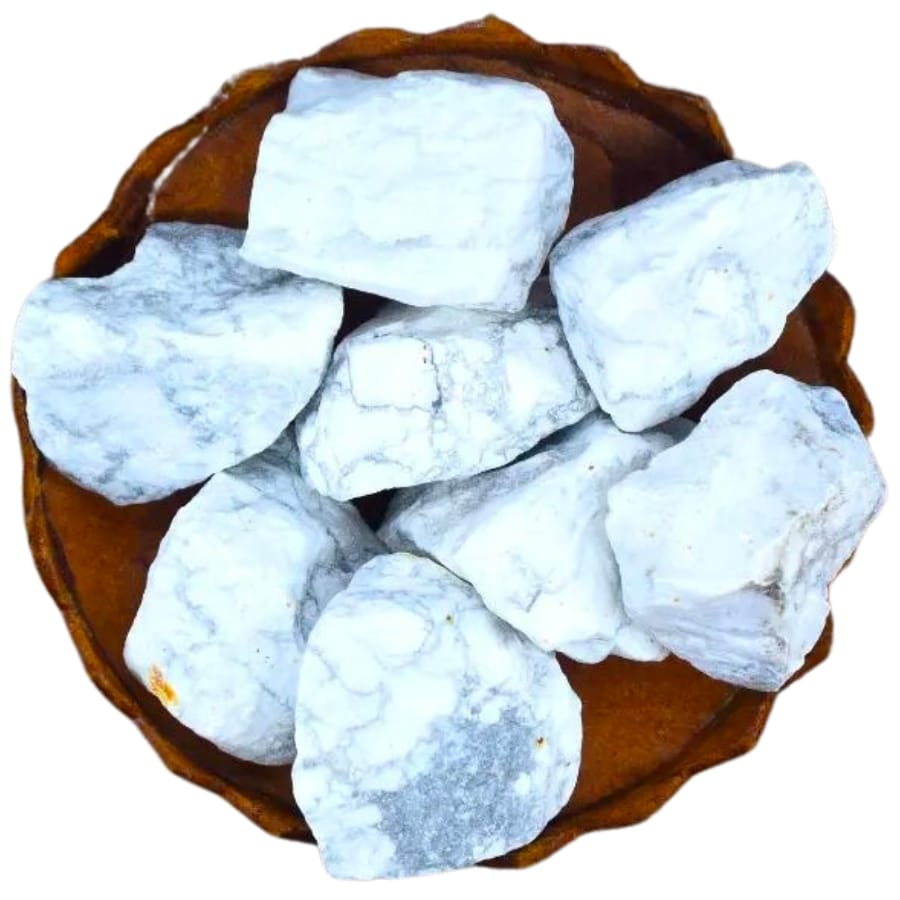
Magnetism is a property that some rocks have that lets them stick to a magnet. But not all rocks have this power. Most don’t.
When it comes to magnesite and howlite, neither of them is magnetic. If you held a magnet up to them, they wouldn’t leap up to stick to it like some other rocks might.
The reason they aren’t magnetic is because they don’t have much iron. Iron is the stuff in rocks that usually makes them magnetic.
Since magnesite and howlite don’t have iron parties going on inside them, they’re not going to dance toward a magnet when it comes close.
So, remember, if you’re ever using a magnet to find out more about a rock, and it doesn’t stick, you might just have one of these two non-magnetic buddies in your hand.
Conductivity – Neither howlite nor magnesite is conductive

Conductivity is all about how well a rock can pass electricity through it. But not all rocks are good at this.
In fact, magnesite and howlite are bad at conducting electricity. If electricity were a bunch of tiny critters trying to run through them, they’d get nowhere fast in both of these rocks.
This is because they are made of minerals that don’t let electricity move through them.
They both contain a bunch of atoms that hold onto their electrons tightly and since electricity is all about electrons moving around, these rocks are like no-go zones.
Even though they’re not into letting electricity flow, that makes them pretty useful. Because they’re like insulators, rocks like magnesite and howlite can be used to protect things from getting zapped.
The Easiest Ways To Tell Magnesite and Howlite Apart
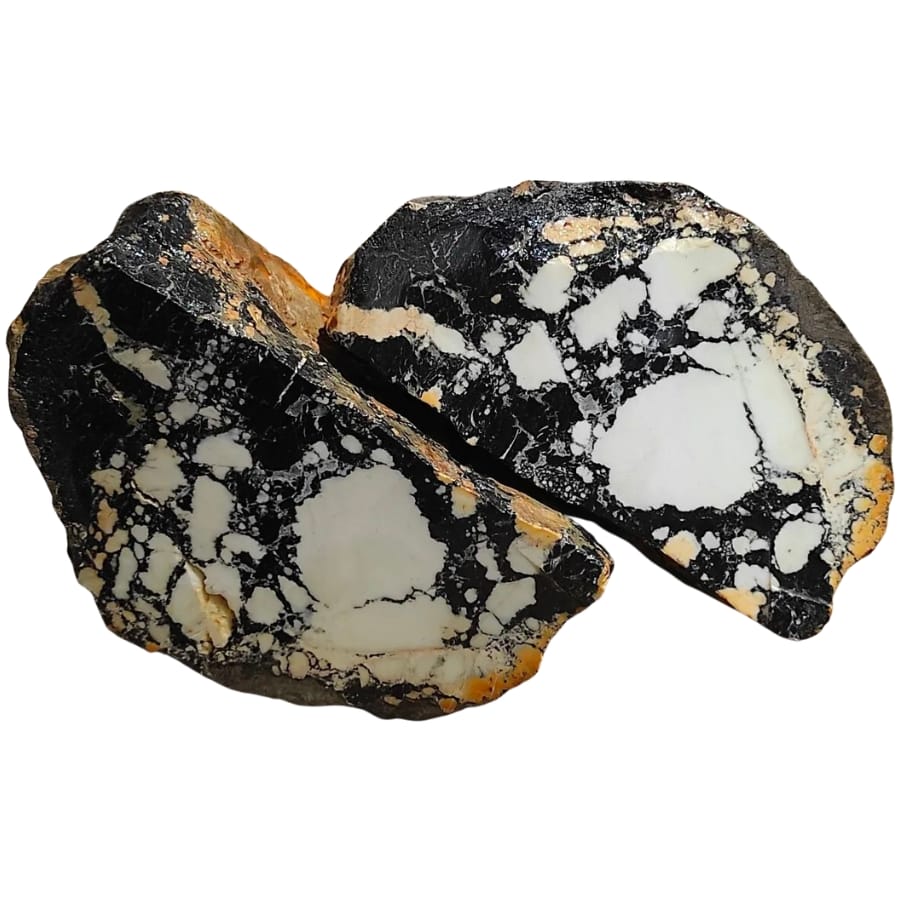
Now that we’ve gone through the similarities and differences between magnesite and howlite, it’s time to put your knowledge into practical application.
Let’s say you have two specimens and you’re unsure which of them is magnesite and which is howlite. Here are some simple tests and observations that you can do:
Check their weight
When trying to tell magnesite and howlite apart, the weight of the stone can be a helpful clue. It’s a simple test that doesn’t need any special tools— just your hands and a good sense of weight.
Even though both rocks have a similar appearance, magnesite is a little heavier. This is because of its density. It has more mass in the same amount of space compared to howlite.
So, if you have two rocks that are about the same size but one feels noticeably heavier, that’s likely the magnesite. The lighter one would be the howlite.
Do a gentle acid test
The acid test works well for figuring out if you’ve got magnesite or howlite. It involves using a weak acid like vinegar and putting a drop on the rock.
Magnesite contains magnesium carbonate, which reacts with the acid. When you drop the vinegar on it, you’ll see it fizz a bit as it releases carbon dioxide gas. It’s like watching a mild version of those fizzy tablets you drop in water.
Howlite, however, won’t react the same way. It’s made of different stuff, mainly calcium borate silicate, which doesn’t have the same reaction with vinegar. So, if you put a drop of vinegar on it, it just sits there, no bubbles, no fizz.
But remember, the reaction can be subtle, so you have to watch closely. And always be sure to do this test on a small part of the rock, so you don’t damage it.
Perform a simple hot-needle test
The hot-needle test is a clever way to identify if a rock is magnesite or howlite, especially if the rock has been polished or treated to look like another mineral. It involves heating up a needle and then gently touching it to the surface of the rock.
If the rock is howlite, which contains borate compounds, the spot where the needle touches might give off a slight odor that’s similar to burning plastic.
Magnesite, on the other hand, doesn’t have the same composition. It’s mostly magnesium carbonate, so when you touch a hot needle to it, you won’t get that plastic smell.
Like the acid test, the hot-needle test should be done with caution to avoid damaging the rock or burning yourself. Also, make sure the area is well-ventilated, as the smell from the test, especially with howlite, can be quite strong.

